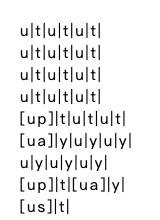Roblox Sheet

Roblox Sheet
Main Theme (From Interstellar)
Hans Zimmer
以全新方式体验 Main Theme (From Interstellar) 由 Hans Zimmer 演绎!使用您的键盘演奏 Main Theme (From Interstellar) Roblox 钢琴谱。无论您是 Roblox 钢琴游戏玩家,还是想练习经典作品,这个 Main Theme (From Interstellar) Roblox 钢琴谱都非常适合您,帮助您从初学者轻松进阶到专家。Main Theme (From Interstellar) 位于 TOP 100 Roblox 钢琴谱之列,还有许多其他简单、经典、流行、圣诞歌曲和迪士尼歌单等您来演奏!
2.0K 浏览
Roblox Sheet

Roblox Sheet
Interstellar Main Theme
Hans Zimmer
以全新方式体验 Interstellar Main Theme 由 Hans Zimmer 演绎!使用您的键盘演奏 Interstellar Main Theme Roblox 钢琴谱。无论您是 Roblox 钢琴游戏玩家,还是想练习经典作品,这个 Interstellar Main Theme Roblox 钢琴谱都非常适合您,帮助您从初学者轻松进阶到专家。Interstellar Main Theme 位于 TOP 100 Roblox 钢琴谱之列,还有许多其他简单、经典、流行、圣诞歌曲和迪士尼歌单等您来演奏!
1.6K 浏览
Roblox Sheet

Roblox Sheet
Interstellar - Main Theme
Patrik Pietschmann
以全新方式体验 Interstellar - Main Theme 由 Patrik Pietschmann 演绎!使用您的键盘演奏 Interstellar - Main Theme Roblox 钢琴谱。无论您是 Roblox 钢琴游戏玩家,还是想练习经典作品,这个 Interstellar - Main Theme Roblox 钢琴谱都非常适合您,帮助您从初学者轻松进阶到专家。Interstellar - Main Theme 位于 TOP 100 Roblox 钢琴谱之列,还有许多其他简单、经典、流行、圣诞歌曲和迪士尼歌单等您来演奏!
324 浏览
Roblox Sheet

Roblox Sheet
Interstellar Main Theme
Hans Zimmer
以全新方式体验 Interstellar Main Theme 由 Hans Zimmer 演绎!使用您的键盘演奏 Interstellar Main Theme Roblox 钢琴谱。无论您是 Roblox 钢琴游戏玩家,还是想练习经典作品,这个 Interstellar Main Theme Roblox 钢琴谱都非常适合您,帮助您从初学者轻松进阶到专家。Interstellar Main Theme 位于 TOP 100 Roblox 钢琴谱之列,还有许多其他简单、经典、流行、圣诞歌曲和迪士尼歌单等您来演奏!
160 浏览
Roblox Sheet

Roblox Sheet
Interstellar
Hans Zimmer
以全新方式体验 Interstellar 由 Hans Zimmer 演绎!使用您的键盘演奏 Interstellar Roblox 钢琴谱。无论您是 Roblox 钢琴游戏玩家,还是想练习经典作品,这个 Interstellar Roblox 钢琴谱都非常适合您,帮助您从初学者轻松进阶到专家。Interstellar 位于 TOP 100 Roblox 钢琴谱之列,还有许多其他简单、经典、流行、圣诞歌曲和迪士尼歌单等您来演奏!
98 浏览
Roblox Sheet

Roblox Sheet
Interstellar Main Theme - simplified for smaller hands
Hans Zimmer
以全新方式体验 Interstellar Main Theme - simplified for smaller hands 由 Hans Zimmer 演绎!使用您的键盘演奏 Interstellar Main Theme - simplified for smaller hands Roblox 钢琴谱。无论您是 Roblox 钢琴游戏玩家,还是想练习经典作品,这个 Interstellar Main Theme - simplified for smaller hands Roblox 钢琴谱都非常适合您,帮助您从初学者轻松进阶到专家。Interstellar Main Theme - simplified for smaller hands 位于 TOP 100 Roblox 钢琴谱之列,还有许多其他简单、经典、流行、圣诞歌曲和迪士尼歌单等您来演奏!
94 浏览
Roblox Sheet

Roblox Sheet
Interstellar Main Theme
Hans Zimmer
以全新方式体验 Interstellar Main Theme 由 Hans Zimmer 演绎!使用您的键盘演奏 Interstellar Main Theme Roblox 钢琴谱。无论您是 Roblox 钢琴游戏玩家,还是想练习经典作品,这个 Interstellar Main Theme Roblox 钢琴谱都非常适合您,帮助您从初学者轻松进阶到专家。Interstellar Main Theme 位于 TOP 100 Roblox 钢琴谱之列,还有许多其他简单、经典、流行、圣诞歌曲和迪士尼歌单等您来演奏!
83 浏览
Roblox Sheet

Roblox Sheet
Interstellar Main Theme
Hans Zimmer
以全新方式体验 Interstellar Main Theme 由 Hans Zimmer 演绎!使用您的键盘演奏 Interstellar Main Theme Roblox 钢琴谱。无论您是 Roblox 钢琴游戏玩家,还是想练习经典作品,这个 Interstellar Main Theme Roblox 钢琴谱都非常适合您,帮助您从初学者轻松进阶到专家。Interstellar Main Theme 位于 TOP 100 Roblox 钢琴谱之列,还有许多其他简单、经典、流行、圣诞歌曲和迪士尼歌单等您来演奏!
81 浏览
Roblox Sheet

Roblox Sheet
Interstellar Main Theme - Message From Home
Hans Zimmer
以全新方式体验 Interstellar Main Theme - Message From Home 由 Hans Zimmer 演绎!使用您的键盘演奏 Interstellar Main Theme - Message From Home Roblox 钢琴谱。无论您是 Roblox 钢琴游戏玩家,还是想练习经典作品,这个 Interstellar Main Theme - Message From Home Roblox 钢琴谱都非常适合您,帮助您从初学者轻松进阶到专家。Interstellar Main Theme - Message From Home 位于 TOP 100 Roblox 钢琴谱之列,还有许多其他简单、经典、流行、圣诞歌曲和迪士尼歌单等您来演奏!
80 浏览
Roblox Sheet

Roblox Sheet
Interstellar Main Theme
Hans Zimmer
以全新方式体验 Interstellar Main Theme 由 Hans Zimmer 演绎!使用您的键盘演奏 Interstellar Main Theme Roblox 钢琴谱。无论您是 Roblox 钢琴游戏玩家,还是想练习经典作品,这个 Interstellar Main Theme Roblox 钢琴谱都非常适合您,帮助您从初学者轻松进阶到专家。Interstellar Main Theme 位于 TOP 100 Roblox 钢琴谱之列,还有许多其他简单、经典、流行、圣诞歌曲和迪士尼歌单等您来演奏!
73 浏览
Roblox Sheet

Roblox Sheet
Interstellar
Hans Zimmer
以全新方式体验 Interstellar 由 Hans Zimmer 演绎!使用您的键盘演奏 Interstellar Roblox 钢琴谱。无论您是 Roblox 钢琴游戏玩家,还是想练习经典作品,这个 Interstellar Roblox 钢琴谱都非常适合您,帮助您从初学者轻松进阶到专家。Interstellar 位于 TOP 100 Roblox 钢琴谱之列,还有许多其他简单、经典、流行、圣诞歌曲和迪士尼歌单等您来演奏!
68 浏览
Roblox Sheet

Roblox Sheet
Interstellar
以全新方式体验 Interstellar 由 演绎!使用您的键盘演奏 Interstellar Roblox 钢琴谱。无论您是 Roblox 钢琴游戏玩家,还是想练习经典作品,这个 Interstellar Roblox 钢琴谱都非常适合您,帮助您从初学者轻松进阶到专家。Interstellar 位于 TOP 100 Roblox 钢琴谱之列,还有许多其他简单、经典、流行、圣诞歌曲和迪士尼歌单等您来演奏!
65 浏览
Roblox Sheet

Roblox Sheet
Interstellar: Main Theme
Hans Zimmer
以全新方式体验 Interstellar: Main Theme 由 Hans Zimmer 演绎!使用您的键盘演奏 Interstellar: Main Theme Roblox 钢琴谱。无论您是 Roblox 钢琴游戏玩家,还是想练习经典作品,这个 Interstellar: Main Theme Roblox 钢琴谱都非常适合您,帮助您从初学者轻松进阶到专家。Interstellar: Main Theme 位于 TOP 100 Roblox 钢琴谱之列,还有许多其他简单、经典、流行、圣诞歌曲和迪士尼歌单等您来演奏!
65 浏览
Roblox Sheet

Roblox Sheet
Interstellar - Main Theme
Hans Zimmer
以全新方式体验 Interstellar - Main Theme 由 Hans Zimmer 演绎!使用您的键盘演奏 Interstellar - Main Theme Roblox 钢琴谱。无论您是 Roblox 钢琴游戏玩家,还是想练习经典作品,这个 Interstellar - Main Theme Roblox 钢琴谱都非常适合您,帮助您从初学者轻松进阶到专家。Interstellar - Main Theme 位于 TOP 100 Roblox 钢琴谱之列,还有许多其他简单、经典、流行、圣诞歌曲和迪士尼歌单等您来演奏!
65 浏览
Roblox Sheet

Roblox Sheet
Interstellar - Day One
Hans Zimmer
以全新方式体验 Interstellar - Day One 由 Hans Zimmer 演绎!使用您的键盘演奏 Interstellar - Day One Roblox 钢琴谱。无论您是 Roblox 钢琴游戏玩家,还是想练习经典作品,这个 Interstellar - Day One Roblox 钢琴谱都非常适合您,帮助您从初学者轻松进阶到专家。Interstellar - Day One 位于 TOP 100 Roblox 钢琴谱之列,还有许多其他简单、经典、流行、圣诞歌曲和迪士尼歌单等您来演奏!
64 浏览
Roblox Sheet

Roblox Sheet
Interstellar - First Step
以全新方式体验 Interstellar - First Step 由 undefined 演绎!使用您的键盘演奏 Interstellar - First Step Roblox 钢琴谱。无论您是 Roblox 钢琴游戏玩家,还是想练习经典作品,这个 Interstellar - First Step Roblox 钢琴谱都非常适合您,帮助您从初学者轻松进阶到专家。Interstellar - First Step 位于 TOP 100 Roblox 钢琴谱之列,还有许多其他简单、经典、流行、圣诞歌曲和迪士尼歌单等您来演奏!
63 浏览
Roblox Sheet

Roblox Sheet
Interstellar
Hans Zimmer
以全新方式体验 Interstellar 由 Hans Zimmer 演绎!使用您的键盘演奏 Interstellar Roblox 钢琴谱。无论您是 Roblox 钢琴游戏玩家,还是想练习经典作品,这个 Interstellar Roblox 钢琴谱都非常适合您,帮助您从初学者轻松进阶到专家。Interstellar 位于 TOP 100 Roblox 钢琴谱之列,还有许多其他简单、经典、流行、圣诞歌曲和迪士尼歌单等您来演奏!
61 浏览
Roblox Sheet

Roblox Sheet
Interstellar - Main Theme
Hans Zimmer
以全新方式体验 Interstellar - Main Theme 由 Hans Zimmer 演绎!使用您的键盘演奏 Interstellar - Main Theme Roblox 钢琴谱。无论您是 Roblox 钢琴游戏玩家,还是想练习经典作品,这个 Interstellar - Main Theme Roblox 钢琴谱都非常适合您,帮助您从初学者轻松进阶到专家。Interstellar - Main Theme 位于 TOP 100 Roblox 钢琴谱之列,还有许多其他简单、经典、流行、圣诞歌曲和迪士尼歌单等您来演奏!
61 浏览
Roblox Sheet

Roblox Sheet
Interstellar
Hans Zimmer
以全新方式体验 Interstellar 由 Hans Zimmer 演绎!使用您的键盘演奏 Interstellar Roblox 钢琴谱。无论您是 Roblox 钢琴游戏玩家,还是想练习经典作品,这个 Interstellar Roblox 钢琴谱都非常适合您,帮助您从初学者轻松进阶到专家。Interstellar 位于 TOP 100 Roblox 钢琴谱之列,还有许多其他简单、经典、流行、圣诞歌曲和迪士尼歌单等您来演奏!
60 浏览
Roblox Sheet

Roblox Sheet
Interstellar
Hans Zimmer
以全新方式体验 Interstellar 由 Hans Zimmer 演绎!使用您的键盘演奏 Interstellar Roblox 钢琴谱。无论您是 Roblox 钢琴游戏玩家,还是想练习经典作品,这个 Interstellar Roblox 钢琴谱都非常适合您,帮助您从初学者轻松进阶到专家。Interstellar 位于 TOP 100 Roblox 钢琴谱之列,还有许多其他简单、经典、流行、圣诞歌曲和迪士尼歌单等您来演奏!
60 浏览



















